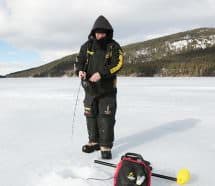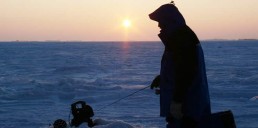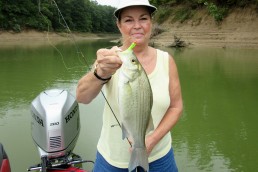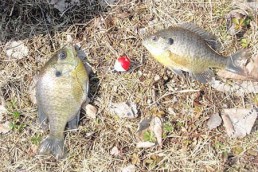The ‘Fresh’ Water Fishing Advantage
SHARE THIS POST
There’s a lot to be said in favor of “fresh” water fishing.
No, I’m not referring to “freshwater” fishing as opposed to saltwater, but rather fishing “fresh” water as it pertains, literally, to ice fishing.
Ever notice how often, after working a hole for a period of time, action will slow, but moving to a freshly drilled hole not far away produces seemingly immediate results?
This is what I mean when I refer to working “fresh” water. Pioneering. Moving to explore new water, seeking out new life—and, most importantly—noting how often such actions can be remarkably productive.
Sure, it’s possible to complete our due diligence, stop at the first planned coordinate, punch a hole, land right on top of an active school and proceed to repeatedly catch a number of fish from that single, initial cut. But more often than not, success depends upon some degree of mobility, and the search for “fresh” water.
You’ve likely seen it happen: You move into an area, set up and promptly hook a fish, maybe even pick up two or three over the course of 10 or 20 minutes before the well suddenly goes dry. It’s possible you’re still marking some fish, perhaps even drawing interest, but just aren’t getting bit.
So you jump to a new hole, where again, it’s good for a fish or two before the action slumps. Might seem puzzling, but should this sequence continue and you’re able to maintain the same productivity long enough, you’ll end up with a respectable catch—this is the crux of the “fresh” water fishing advantage.
The reasons for such changes are obvious: Perhaps the fish simply moved deeper, shifted toward a form of obvious cover, followed a significant concentration of forage or spooked.
But the reason “fresh” water often proves productive can also be due to much more subtle factors. In fact, there are times when there appears to be no logical explanation at all. This is when it becomes fun to start theorizing. And if you’re ultimately able to figure out what’s happening, theory may not only help you achieve heightened levels of success, but discover powerful new patterns offering great rewards.
I’ve become somewhat obsessed with this process, leading me to test a few theories. And cold as my brain often becomes while on location, I’ve explored some ideas that have proven valid, while others based on speculation have brought mixed results. So, for what it’s worth, these theories are by no means a scientific or complete account, just the sharing of a few considerations:
Physical anomalies
The most reasonable, easy way to substantiate the productivity of one freshly drilled hole over another is a physical change, but this may not always be a prominent, or recognizable one.
If your first hole is 5 feet deep and the second is 10, the obvious depth change may be important. But if you’re fishing a shallow flat, a 6-inch depression might substantiate an equally significant find, yet one much more easily overlooked.
Similarly, distinct physical weedlines following sharp breaking drop-offs on a deep lake are easily identifiable. Slight changes in height or density of the weed growth amid an expansive, heavily vegetated flat, however, aren’t nearly as perceptible and often go unnoticed. Yet, regardless of how subtle these variations in the cover may be or difficult to distinguish, they may be of no less consequence than a distinct breakline or weedline.

Another physical anomaly that’s often overlooked is variation in the type of vegetation present. A change from coontail to cabbage might be easily noted—while sight fishing or using an underwater camera—but it’s not as easily identified when fishing the same situation in deeper water with sonar.
Same with monitoring the health of the vegetation you’re fishing. Last season, while using sonar, we located a relatively deep, vegetation-covered sunken island that appeared to offer outstanding potential for bluegills. Reviewing with an underwater camera, however, revealed expansive portions of these weeds had died off on one entire side and weren’t holding any fish—likely the result of oxygen counts being lowered to undesirable levels. Fortunately, we didn’t give up. Further scouting revealed the other side supported healthy green vegetation holding fish that might easily have been overlooked if we hadn’t probed the feature more closely.
Are you enjoying this post?
You can be among the first to get the latest info on where to go, what to use and how to use it!
Fish following a contour
Again, you’d think this would be obvious, but another reason one hole can go dormant and another nearby be productive is simply because the school you’re working has moved—this isn’t always realized. There may be no physical variation whatsoever in terms of depth or cover; you might simply catch a couple fish from an active school, move in the right direction and catch a couple more by following the school as it proceeds along the same break.
Should you be working an elongated breakline outlining substantial structure on a massive body of water, noticing this phenomena and continually working “fresh” water by staying on top or ahead of the school may make the difference between a great and mediocre day.
You might also intercept a loosely congregated school circling through a particular area—something often indicated by clustered anglers hunkered down in one location, periodically catching a fish or two and then sitting idle in regular intervals before catching another. They’re simply planted along a route where the school is repeatedly passing through.
If you can decipher such movements, you can plunk down and wait the fish out, or, by strategically timing movements and working “fresh” water, follow the school and enjoy more consistent action while staying on top of those fish.
Fish scattered across a flat
The “fresh” water technique also works well when fish aren’t schooled, but rather, scattered across a large structure or flat. In this case, you may only catch a fish or two from each hole cut, so the more you drill, the greater you increase your success. This is particularly true when scattered fish aren’t moving much or chasing baits.
Now, it’s not just beneficial to go to the fish—it’s critical. If the fish aren’t moving, and neither are you, the results are destined to be poor.
A similar situation can develop when fish are active, but can’t see well due to dark colored water, dense cover or lack of light penetration. And to complicate matters, a combination of the above. Again, given such conditions, fish are likely to scatter. When this happens, the more fresh water you try, the greater the likelihood you’ll be lowering your presentation within the visual range of an actively feeding fish.
Presence of current
Other variables may have a strong influence upon the fresh water theory, including the presence of current. If currents are consistent in terms of speed and direction (such as when fishing a river channel) fish will often set up behind current-breaking obstructions. Holes must be drilled with some degree of precision so select baits can be positioned where these fish will see and be willing to move out, intercepting them.
You can take advantage of this by drilling your holes strategically over current-blocking features, focusing on pockets behind them where fish are likely to settle in and feed, and simply rotate your efforts between these select holes.
On larger bodies of water—a deep reservoir or Great Lakes basin featuring areas of open water—currents are often wind generated, therefore more dynamic, shifting in both strength and direction. Corresponding fish movements will mirror this, so moving from hole to hole and covering fresh water may help determine specifically where and how these fish are positioning and play a vital role in consistent success.
Shading
Fish positioning may also be affected by other ranging variables, such as sunlight. As the day progresses and the angle of the sun changes, shadowing effects occur beneath the ice. Fish may shift to the shaded side of something as prominent as a sharp drop, or as minutely discreet as a difference in the type, height or density of the cover present. These movements may be subtle in the short term, yet become quite significant over the course of the day. Realizing them will certainly be to your benefit.
This discussion could continue, but it really boils down to two things: If the action slows in one hole, it can’t hurt to try another. And, should such moves initially pay off but then stall, you must continue hole hopping, always working to determine the reasons why certain moves are proving productive while others aren’t—then you recognize those patterns and cash in.
I think most ice anglers—at least to some degree—are aware of the “fresh” water fishing advantage. Those able to recognize details are simply destined to experience more successful, consistent results.
Tom Gruenwald has contributed to the modern “ice fishing revolution” over the years by authoring hundreds of magazine articles and four books on the subject, all while spending countless hours promoting the sport through his seminars, appearances and award-winning television program, “TGO, Tom Gruenwald Outdoors,” now airing on Sportsman Channel, Wild TV and Midco Sports.
MWO
SHARE THIS POST
Did you enjoy this post?
You can be among the first to get the latest info on where to go, what to use and how to use it!
Tom Gruenwald
Tom Gruenwald has penned hundreds of informative ice-fishing articles and blogs, been a frequent and popular guest on outdoor speaking circuits, radio and television, has authored four ice-fishing books, and formerly hosted Tom Gruenwald Outdoors, a nationally syndicated television show dedicated solely to the sport of ice-fishing.



